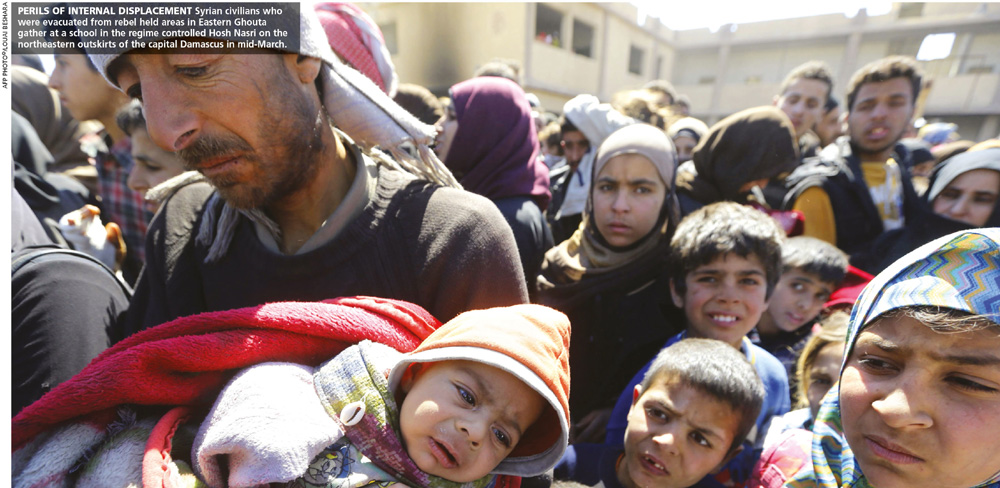HUMANITARIAN INTERVENTION
RESPONSIBILITY TO PROTECT WHOM?
Yasmin Helal ponders the moral and legal implications of the Responsibility to Protect principle that is underpinned by a UN mandate
When the second Gulf War was being fought, former UN Secretary-General Kofi Annan wrote in his Millennium Report of 2000 that events of the Rwandan genocide and Srebrenica massacre were still fresh in his memory.
Among other things, he contemplated different ways through which the international community could have prevented such tragedies from taking place.
Annan said that while military intervention carried out without the authorisation of the UN Security Council may erode the legal framework, the organisation’s failure to prevent humanitarian atrocities would betray its commitment to uphold human rights.
He wrote: “If humanitarian intervention is indeed an unacceptable assault on sovereignty, how should we respond to a Rwanda, to a Srebrenica, to gross and systematic violation of human rights that offend every precept of our common humanity?”
Following the 2005 World Summit, the UN Security Council unanimously adopted Resolution 1674 in April 2006, which related to the protection of civilians in armed conflict. Previously in October 2005, the council had adopted Resolution 1631 to strengthen cooperation between the UN and regional organisations in maintaining international peace.
Meanwhile, in response to Annan’s Millennium Report, the Canadian government established the International Commission on Intervention and State Sovereignty (ICISS) in December 2001. And ICISS issued a report titled ‘The Responsibility to Protect’ a.k.a. R2P.
According to an article published by the United Nations, the report found that “sovereignty not only gave a state the right to ‘control’ its affairs but also conferred on the state primary ‘responsibility’ for protecting the people within its borders.”
Furthermore, it proposed that “when a state fails to protect its people – either through lack of ability or a lack of willingness – the responsibility shifts to the broader international community.”
The R2P commitment stands on three pillars. Pillar 1 acknowledges that sovereign states have an obligation to carry the primary responsibility to protect their citizens from mass atrocities. Pillar 2 declares that the international community is responsible for assisting states in capacity building to prevent mass atrocities – before, during and after conflict. Pillar 3 asserts that if the state in question fails to act appropriately, responsibility to do so in a timely and decisive manner – either diplomatically, humanitarianly, peacefully and as a last resort, through stronger measures – falls on a larger community of states.
While many states favoured the R2P principle, others considered it illegal for the UN Security Council to authorise coercive action against sovereign states.
Its main supporters included the Western European nations while members of the Non-Aligned Movement opposed it, most Latin American countries weren’t too sure, and China and Russia viewed the stipulation with caution. Even the US was hesitant. Those who were against included India and Pakistan, as well as most Middle Eastern countries.
What went a long way in favour of R2P was the extensive support it received from nations in the global south like Mexico, Argentina and Chile. The support of countries in the African Union also contributed greatly to the legitimacy of the principle.
In fact, they had already adopted a similar resolution in the African Union mainly due to genocide and atrocities across the continent. Indeed, the southern support prevented the doctrine from being perceived as a part of a northern agenda.
In 1986, the British Foreign Office stated that the UN Charter and international law do not incorporate such rights in specific terms. It also highlighted the potential abuse that such principles could unleash. History offers nothing but a handful of cases throughout the past two centuries where intervention revolved around genuine humanitarian objectives.
Looking back at when the international community decided to act on the basis of R2P, its shortcomings become clear. The doctrine was applied in Libya in 2011 when for the first time, the UN deployed NATO troops on the grounds of R2P. But the mission failed and left devastation in its wake.
Clouded by a call by both Western and Arab nations to end the rule of Colonel Muammar Gaddafi in Libya, NATO fought a war where the line between regime change and prevention of atrocities was blurred.
The Economist said in an article published at the time that “power politics decides which lives get saved and which policy aims triumph.” This sentiment was reflected in news headlines around the world in the wake of the Libyan debacle.
India’s former Permanent Representative to the UN Hardeep Singh Puri noted that “Libya has given R2P a bad name.” He averred that the principle was used as an excuse to topple Gaddafi, and cited the commonly held belief that civilians were given arms and the no-fly zone applied only in selected areas.
Thereafter, it became increasingly difficult for the UN to make any decisions regarding Syria on the basis of R2P. Russia and China have vetoed every resolution that has been proposed regarding Syria, and the Arab nations have learnt to step back and not call for a similar intervention in the region.
What’s more, it is highly unlikely that the UN will ever make another case for intervention based on R2P in the near future.




